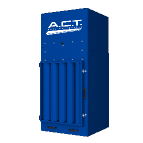 The grinding of metals and non-ferrous metals produces a fine dust that needs to be removed from the air. When metal particles from grinding and other metalworking applications become airborne, metal dust becomes a hazard.
The grinding of metals and non-ferrous metals produces a fine dust that needs to be removed from the air. When metal particles from grinding and other metalworking applications become airborne, metal dust becomes a hazard.
Metalworking equipment tends to throw this dust around quite frequently, and while grinding dust can’t be completely avoided, it can be contained and controlled. Even with state-of-the-art equipment, grinding dust has to be dealt with so that you can:
- Keep your plant running efficiently with little or no interruptions
- Retain team members and ensure they’re productive and happy
- Maintain a safe and clean work environment
- Reduce equipment maintenance costs
This means keeping your facility free of grinding dust can be good for your employees and your bottom line. Having a proper grinding dust collection system in place will help keep your employees safe and the company in compliance with regulations and standards.
Keeping the air quality in your facility up to local standards and regulations will help strengthen your team and help to increase efficiencies. By providing suitable industrial dust collection systems, employees are happy and employee turnover is often reduced. This often translates to increases in production and company growth.
Warning Signs That You Need a dust collector for metal grinding
Sometimes the need for a dust collector in a facility is more obvious than in others. However, there are a few warning signs that signal when there’s a need for a grinding dust collection system.
1. Can you see smog or a cloud of dust in the work area? If dust particles are gathering to form clouds of dust, there is a need for dust collection.
- A quick test: Observe the air in the facility. Does it appear to be hazy?
- A quick test: Calculate how many hours the doors and windows are being opened to air out the facility.
3. Are the HVAC air vents and filters continually clogged with dust? If dust is collecting in the heating and cooling vents, there is a need for dust collection. The filters and vents are built to collect moderate amounts of dust, but they should not be continually clogged.
- A quick test: Monitor how often the filters are changed on the heater and air conditioners.
4. Are pieces of equipment in the facility or work area covered with a thick layer of dust? If there is dust buildup on equipment that has been cleaned within the past 1-2 days, there is a need for dust collection.
- A quick test: Clean a flat surface in the facility. Check the surface after 1-2 days to see if there is a major dust buildup.
If your answer to any of these questions is yes, you likely need a metal grinding dust collector. Some particulate is so small that it cannot be seen by the naked eye, so it’s important to check for all of these indicators.
Discover the Benefits of a Surface Grinder Dust Collector
A.C.T. Dust Collectors offers solutions for all your grinding dust collection needs. Our team will assist in choosing the perfect grinding dust collection system for you, whether it’s your first dust collector or an upgrade to a current system.
Every surface grinder dust collector we manufacture comes standard with high-efficiency Nano-Elite cartridge filters that feature a Minimum Efficiency Reporting Value (MERV) 15 rating for effective collection of extremely fine dust — capturing 99.99% of particulate from the air.
Designed with quality, value and simplified maintenance in mind, quick-lock, easy-access filter doors and downward flow technology are exclusive features that allow for easy access, fast filter replacements and reduced downtime.
Cartridge collectors are typically best for grinding applications, though it can be a case-by-case situation.



























%20Collectors%20Image.png?width=143&height=143&name=ADC%20(Ambient)%20Collectors%20Image.png)




























.png?width=240&height=91&name=ACT%20Dust%20Collectors%20Logo%20Solid%20White%202020%20(1).png)
.png?width=148&height=149&name=usa-manufactured-dust-collectors%20(1).png)